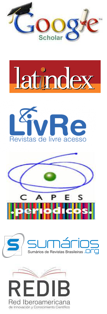Revisão Sistemática sobre Desenho Universal para a Aprendizagem entre 2010 e 2015 no Brasil
DOI:
https://doi.org/10.17921/2447-8733.2017v18n4p414-423Resumo
Para suprir as necessidades de uma prática pedagógica inclusiva, o Desenho Universal para a Aprendizagem - DUA tem representado uma possibilidade qualitativa para com as intenções e a efetivação da inclusão educacional no contexto educacional brasileiro. Portanto, esta pesquisa emergiu da seguinte questão de investigação: de que maneira o Desenho Universal para a Aprendizagem tem sido contemplado nas publicações científicas brasileiras? Para tanto, utiliza-se como metodologia de pesquisa a revisão sistemática das produções científicas brasileiras dispostas e selecionadas no banco de dados do Google Acadêmico e Portal de Periódicos da Capes, que possibilitou a análise de 23 produções. Estes estudos foram classificados e organizados em quatro categorias: (i) que apresentam resultados referentes a um levantamento bibliográfico selecionadas, (ii) que apresentam resultados referentes à pesquisa bibliográfica e propõe apresentar resultados de uma pesquisa de campo, (iii) que apresentam resultados para a construção/uso de um objeto de ensino e, (iv) que apresentam resultados referentes à pesquisa de campo, após análise da aplicação subsidiada ou o não uso do DUA. Como principal resultado e discussão, a pesquisa revela a necessidade de pesquisas que abordem a contribuição didática no campo da prática docente para inclusão educacional no contexto do ensino regular. As pesquisas também evidenciam a necessidade de formação docente para a implantação do DUA no planejamento de ensino e elaboração de atividades pedagógicas inclusivas, que contemplem o uso de recursos tecnológicos potencializando o processo de ensino e de aprendizagem.
Palavras-chave: Desenho Universal para a Aprendizagem. Revisão Sistemática. Análise. Produções Científicas.
Abstract
To supply the inclusive pedagogical practices necessities, the Universal Design for Learning (DUA, acronym in Portuguese for Desenho Universal da Aprendizagem) has represented a qualitative possibility in relation to the intentions, and implementation of the educational inclusion in the Brazilian educational context. Thus, this article has emerged from the following investigation question: how has the Universal Design for Learning been contemplated in the Brazilian scientific publications? For this purpose, as the research methodology, it is used the systematic review of the Brazilian scientific productions, in which 23 productions were selected in the Academic Google and in the Capes Periodical Portal. These studies were classified and organized in 4 categories: First, that presents selected results about a bibliographical survey; second, that shows results about the bibliographic research that intends to present results of a field research; third, results for construction/use of a teaching object, and fourth, results about the field research after the analysis of the subsided application with the DUA use or not. The main result and discussion of this research reveal the necessity of works that deal with the didactic contribution in the teacher’s practice field for educational inclusion in the regular teaching context. The bodies of research also highlighted that the teacher’s education for the DUA implementation, in the teaching and in the inclusive pedagogical activities, are necessary to contemplate the use of technological resources, maximizing the process of teaching and learning.
Keywords: Universal Design for Learning. Systematic Review. Analysis. Scientific Productions.



